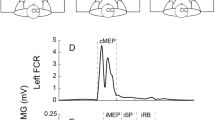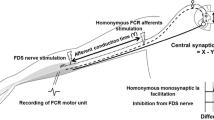Abstract
Experiments were done on nine cats anaesthetized with pentobarbitone to determine whether motor cortical zones controlling antagonistic muscles are synaptically interconnected. Motor cortical zones controlling wrist flexors, or extensors, were identified by microstimulation and intramuscular electromyographic recordings (microstimulation: 11 pulses at 333 pulses/s, current 10–40 μA). The position of each zone of interest was marked by a small ink spot on the surface of the cortex and on a scaled drawing of the cortical surface (cruciate region). Following the identification of wrist flexor and extensor zones the anterograde tracer biocytin was injected into one, or two, wrist extensor zones at three depths (400, 800 and 1500 μm) from the cortical surface. A small injection of horseradish peroxidase (HRP) – producing a dark brown spot of approximately 300–500 μm – was made in layer II–III of one or more wrist flexor zones. Similar HRP injections were made in the deep layers of wrist extensor zones that were not labelled by biocytin. The HRP injections served to mark the position of potential targets of biocytin-labelled fibres. In some experiments the biocytin was injected into a wrist flexor zone and HRP was deposited in one or more wrist extensor zones. Biocytin-labelled fibres (blue) were found throughout the expanse of the forelimb representation zone, as has been previously reported. More specifically, in all animals biocytin-labelled fibres were found in identified cortical zones controlling the same muscle(s) as well as in zones controlling an antagonist(s). Club-like swellings, indicative of synaptic boutons, were observed on these fibres. The density of labelled fibres was greater in the upper cortical layers (II–III), but a large number of terminals were also present in the lower cortical layers (V–VI). We conclude that there exist intracortical circuits linking motor cortical zones controlling antagonistic muscles. Elucidating the nature and function of these circuits is likely to be important for understanding the mode of operation of the motor cortex.
Similar content being viewed by others
Author information
Authors and Affiliations
Additional information
Received: 24 March 1997 / Accepted: 13 October 1997
Rights and permissions
About this article
Cite this article
Capaday, C., Devanne, H., Bertrand, L. et al. Intracortical connections between motor cortical zones controlling antagonistic muscles in the cat: a combined anatomical and physiological study. Exp Brain Res 120, 223–232 (1998). https://doi.org/10.1007/s002210050396
Issue Date:
DOI: https://doi.org/10.1007/s002210050396




